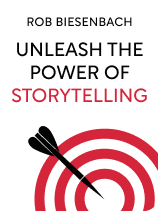

This article is an excerpt from the Shortform book guide to "Unleash the Power of Storytelling" by Rob Biesenbach. Shortform has the world's best summaries and analyses of books you should be reading.
Like this article? Sign up for a free trial here.
Do you talk about your company’s timeline, only to have people tune out? How well do people know the journey that your organization is on?
In his book Unleash the Power of Storytelling, Rob Biesenbach contends that you can make any message much more compelling by simply telling a story. He shares his practical template for a narrative that explains your company’s history, mission, and values in an engaging way.
Read on to learn the importance of a corporate story and how to create one for your organization.
Your Corporate Story
When you need to talk about your company and the work you do, a great story plays a crucial role in holding your audience’s interest. Biesenbach explains that businesses, nonprofits, and other organizations need an “origin story” that presents their history and purpose and humanizes the people behind the scenes. A corporate story is more compelling and memorable than a dry corporate timeline, which typically just lists dates and milestones without a narrative arc to connect them.
(Shortform note: Not everyone thinks that a company’s origin story is the important one to tell. Writer John Hagel III thinks that a story is too self-contained because it has an ending. He suggests that in a corporate context, narratives should be about the customer, not the company, and advocates for creating a narrative where the resolution is dependent on the listener’s actions—which can create a compelling call to action.)
When you’re telling a corporate story, you need to tailor the story to what the company can do for the audience. Like any good story, this kind of story needs a relatable character and a clear theme. Biesenbach notes you should pick just one value proposition to focus on rather than trying to address everything the company does. Many company origin stories follow a familiar pattern, which you can adapt:
- The founder encounters a problem.
- They make a discovery or invent a solution.
- They turn their idea into a product or service.
- They grow their business.
- The business continues to operate on its original values.
(Shortform note: A company origin story can communicate a message to audiences inside and outside your organization. Just Go With It author Mandy Gilbert explains that a company origin story can help a business attract both customers and talent. She recommends a few steps for crafting an origin story in a process that’s less focused on the chronology of the company than Biesenbach’s model. She advises that you start the story with the “aha” moment that kickstarted the company rather than the problem the founder encountered, be transparent about the mistakes you made along the way, and share your excitement with your audience.)
Company origin stories that follow Biesenbach’s template are everywhere, including behind some of your favorite products. For instance, here’s the story of Fender Guitars: In the 1940s, a radio repairman named Leo Fender saw that musicians needed an electric guitar that was more durable, more affordable, and easier to amplify than the archtop guitars they were playing at the time. In 1951, he introduced a solid-body guitar he called the Telecaster, which had a bright sound that made the guitar into a lead instrument. Inventions like the Precision Bass, Stratocaster, Jaguar, Jazzmaster, and Twin Reverb amplifiers followed. Each one was a new tool that changed how people make music, a mission that Fender still pursues today.
(Shortform note: A company origin story isn’t the only story that can help customers see value in your brand. In Building a StoryBrand, Donald Miller outlines a seven-part formula for a marketing story, which casts a customer as the main character and tells a story about a product. The customer wants something and encounters a problem. The brand steps in with a plan to help and tells the customer how they can solve the problem. The negative outcome of not taking action becomes clear, and the positive outcome of following the plan is the happy ending.)

———End of Preview———
Like what you just read? Read the rest of the world's best book summary and analysis of Rob Biesenbach's "Unleash the Power of Storytelling" at Shortform.
Here's what you'll find in our full Unleash the Power of Storytelling summary:
- How telling a story can make any message more compelling
- The unique power stories have to influence us and shape our emotions
- The crucial pieces that make up a story (other than the beginning, middle, and end)






